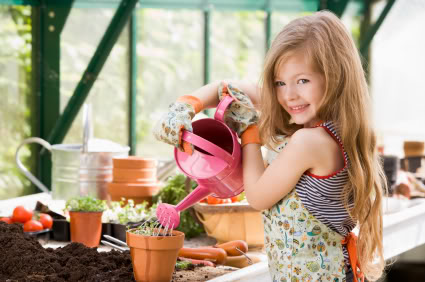Backyard Greenhouse Basics

Growing and maintaining plants in a backyard greenhouse doesn’t require a master gardener certification. It just takes some diligence and attention to the plants’ temperature, light and moisture needs. This publication, Growing Indoor Plants with Success from the University of Georgia, lists the requirements for a range of plants.
Gardeners should set a daily routine for backyard greenhouse work. A five-minute walk-through should be adequate for most days. If the walk-through seems more like a chore than a relaxing pleasure, it may be time to scale back the greenhouse or find another hobby. Plants need regular water and fertilizer and should be inspected daily for pests and to measure growth. Also, measure and control temperature, light and humidity.
Control the Temperature
Use heaters and vents to manage the air temperature in a backyard greenhouse. Don’t wait until the first freeze to turn on the heat, and remember that extreme summer heat can be as damaging as extreme winter cold. Greenhouses full of tropical plants are expensive to heat, and cold greenhouses only allow for a small range of cold-hardy plants. The majority of backyard greenhouses are kept in a moderate temperature range between 50 and 70 degrees Fahrenheit. This range can support a wide range of temperate to subtropical foliage, flowers and vegetables.
Make sure your water and soil are also in the appropriate temperature range. Spraying cold water can shock the plants and cause leaf spots, and hot water can burn the leaves. Heating pads and tubes can raise the soil temperature in backyard greenhouses.
Lighten Up
Plants’ light needs vary, but a general rule of thumb is that flowering plants need about twice as much light as foliage, so some areas of a backyard greenhouse may need additional artificial lighting. The most productive and energy-efficient supplemental light source is a set of full-spectrum fluorescent light tubes. To determine how much supplemental light or shade you need in a backyard greenhouse, place a flat white sheet of paper on the surface you need to measure. Then set the shutter speed on your camera to 1/60 second and try to take a picture of the paper with a camera. Adjust the F-stop until you can take the photo. An F-Stop setting of 3 translates to 200 foot-candles, enough for rubber trees and most ferns. An F-Stop setting of 16 equals 5,000 foot-candles, the optimal level for cacti and many vegetables. You may need extra light during the day, or to extend short winter days to encourage flowering and growth.
Check the Humidity
Regularly measure and adjust the humidity in a backyard greenhouse. Most plants lose water faster than they can replace it if the humidity stays below 50 percent. At the other extreme, 80% humidity can promote leaf disease in some plants, but can help tropical plants thrive. Boosting humidity can be as simple as misting the plants or watering the floor, or it may require a permanent mist system. Newer mist systems include humidity controls that shut off if water builds up on their monitors. To reduce humidity, open vents and switch on fans. Control the temperature, light and humidity to maintain a successful backyard greenhouse all year.
Author Steve Graham is an expert on green building who writes for several home improvement publications. He’s full of great, practical home improvement answers, and incidentally, he’s pretty funny, so send him a message.
Looking for a Pro? Call us (866) 441-6648

Landscaping Average Costs
Landscapers Experiences

Leaf Removal This Year, More Landscape Work Next Summer

Lawn Repair: Contractor Followup To My DIY Prep Got The Job Done



